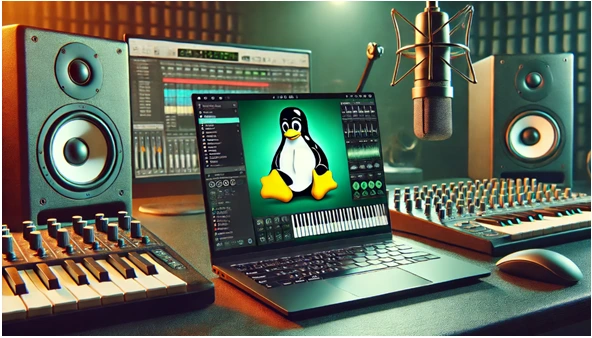In the world of music production, your tools can make or break your creativity. While many producers stick to traditional operating systems, Linux is quietly taking the music industry by storm with its powerful, open-source capabilities. Imagine having access to a high-performance system with zero licensing costs and a vast array of software at your fingertips. Sounds intriguing, right?
Linux has evolved into a platform that caters to creative professionals like never before. Whether you’re a budding producer looking for reliable tools or a seasoned artist seeking ultimate customization, Linux offers something for everyone. In this blog, we’re diving into the top five Linux distributions (distros) that are set to revolutionize music production in 2025. Let’s find the perfect one for your studio!
Top 5 Linux Distros for Music Production in 2025
1. Ubuntu Studio
When it comes to music production, having the right tools and environment can make all the difference. While Windows and macOS dominate the music production landscape, Ubuntu Studio, a Linux-based distribution, has been steadily gaining ground among musicians, producers, and audio enthusiasts. In 2025, Ubuntu Studio stands out as a powerful, free, and open-source operating system tailored specifically for creatives.
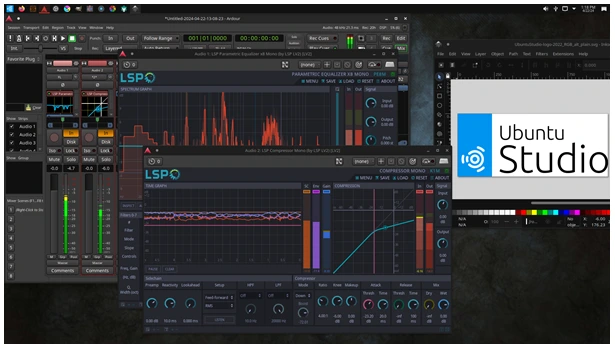
What is Ubuntu Studio?
Ubuntu Studio is a flavor of the popular Ubuntu Linux distribution, designed with multimedia creators in mind. Whether you’re into audio production, video editing, graphic design, or photography, Ubuntu Studio offers a suite of pre-installed applications to meet your needs. However, its audio production capabilities truly set it apart, making it a top choice for music producers looking to escape the proprietary ecosystems.
Key Features for Music Production
Real-Time Kernel Support:
Ubuntu Studio comes with a low-latency kernel, essential for minimizing audio latency during recording and playback. This ensures smooth performance, even when working with large, complex projects.
Jack Audio Connection Kit (JACK):
JACK is a professional-grade audio server that allows seamless routing between applications and devices. With tools like QjackCtl, you can create intricate audio workflows that rival high-end commercial solutions.
Pre-Installed Audio Tools:
Ubuntu Studio includes a comprehensive suite of audio production software, such as:
- Ardour: A full-featured digital audio workstation (DAW) for recording, editing, and mixing.
- Audacity: Perfect for quick edits and audio clean-up.
- Hydrogen: An intuitive drum machine for beat creation.
- ZynAddSubFX: A powerful software synthesizer for crafting unique sounds.
- Carla: A versatile audio plugin host for VST, LV2, and LADSPA plugins.
Plugin Support:
Ubuntu Studio supports a wide range of plugins, including open-source options and commercial VST plugins. With Wine and tools like yabridge, you can even run many Windows-based plugins on Linux.
Studio Controls:
This centralized tool simplifies the configuration of audio settings, making it easier for beginners to dive into professional-grade music production.
Flexible Workflow:
Thanks to its modular architecture, Ubuntu Studio lets you customize your workflow. You’re not locked into a specific DAW or audio tool, allowing you to mix and match software that suits your style.
Why Choose Ubuntu Studio in 2025?
- Cost-Effective:
Unlike macOS or Windows, Ubuntu Studio is completely free. This makes it an excellent choice for independent musicians and small studios operating on a budget.
- Open-Source Freedom:
With Ubuntu Studio, you have full control over your operating system and software. No license fees, no subscriptions, and no invasive telemetry—just a pure focus on creativity.
- Improved Hardware Support:
Linux has come a long way in terms of hardware compatibility. In 2025, Ubuntu Studio supports a wide range of audio interfaces, MIDI controllers, and other peripherals out of the box.
- Thriving Community:
The Ubuntu Studio community is active and welcoming, offering forums, documentation, and tutorials to help you get started and troubleshoot issues.
- Eco-Friendly Computing:
Ubuntu Studio runs efficiently on older hardware, reducing electronic waste and making it a sustainable choice for eco-conscious creators.
Getting Started with Ubuntu Studio
- Download and Install:
Head to the official Ubuntu Studio website to download the latest ISO image. Installation is straightforward and well-documented.
- Optimize Your Setup:
After installation, use the Studio Controls tool to configure your audio settings and ensure your hardware is correctly recognized.
- Explore the Software:
Take some time to explore the pre-installed applications and experiment with different workflows. The more you experiment, the more you’ll appreciate the flexibility Ubuntu Studio offers.
- Join the Community:
Engage with the Ubuntu Studio community on forums, Reddit, or social media. Share your experiences, ask questions, and learn from other users.
Ubuntu Studio in 2025 is a testament to the power and versatility of open-source software for music production. With its rich feature set, zero-cost barrier, and active community, it’s an excellent choice for anyone looking to create music without the constraints of proprietary systems. Whether you’re a seasoned producer or just starting your journey, Ubuntu Studio has everything you need to bring your musical ideas to life.
2. AV Linux
In the world of music production, having the right tools can make all the difference. While many producers swear by macOS or Windows for their Digital Audio Workstation (DAW) setups, Linux enthusiasts know there’s a hidden gem specifically designed for audio creatives: AV Linux. As we step into 2025, AV Linux continues to shine as one of the best Linux distributions for music production. Here’s why.
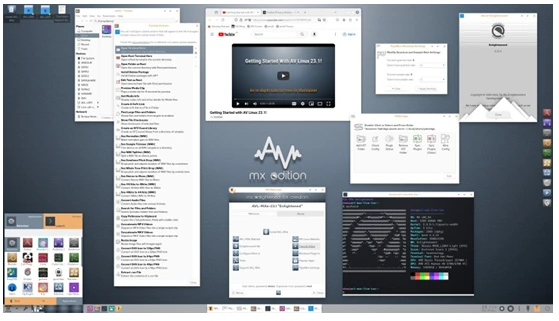
What is AV Linux?
AV Linux is a Debian-based distribution tailored for audio and video production. It comes preloaded with an impressive suite of software and optimizations to help artists, producers, and engineers focus on their craft without being bogged down by technical hurdles. Whether you’re a seasoned producer or just starting out, AV Linux provides a seamless environment for creating high-quality audio projects.
Why Choose AV Linux for Music Production?
Real-Time Kernel Support
One of the standout features of AV Linux is its real-time kernel. Real-time kernels are optimized for low-latency audio processing, ensuring that your music production setup runs smoothly, even under heavy workloads. This is a game-changer for live recording sessions and performances where timing is critical.
Preinstalled Audio Tools
AV Linux comes with a curated selection of preinstalled audio software, saving you hours of setup time. Some of the included tools are:
- Ardour: A powerful DAW for recording, editing, and mixing audio.
- Audacity: A user-friendly audio editor for quick tasks.
- Hydrogen: A feature-rich drum machine.
- Qtractor: A multi-track sequencer for MIDI and audio production.
- Jack Audio Connection Kit: A professional-grade audio server for routing and processing audio signals.
These tools cover everything from recording and mixing to mastering, making AV Linux a one-stop shop for music production.
Optimized Performance
AV Linux is pre-configured with performance tweaks that cater to the demands of audio production. From reducing background processes to fine-tuning CPU usage, these optimizations ensure that your system resources are dedicated to your music projects.
Versatile Hardware Compatibility
Unlike some distros that struggle with specialized hardware, AV Linux boasts excellent support for a wide range of audio interfaces, MIDI controllers, and studio gear. This makes it a reliable choice for both home studios and professional setups.
Active Community and Support
The AV Linux community is a treasure trove of knowledge and support. Whether you’re troubleshooting an issue or exploring advanced workflows, you’ll find forums, documentation, and fellow users ready to help.
What’s New in AV Linux 2025?
The latest release of AV Linux in 2025 brings several exciting updates:
- Wayland Support: While AV Linux still prioritizes X11 for its stability in production environments, the addition of Wayland support ensures compatibility with modern displays.
- Updated Software: All preinstalled tools have been updated to their latest versions, ensuring compatibility with new plugins and features.
- Improved Real-Time Kernel: The kernel now includes better support for multi-core processors, further reducing latency and improving performance.
- Flatpak Integration: Users can now easily install Flatpak applications, expanding the software ecosystem available on AV Linux.
Who Should Use AV Linux?
AV Linux is perfect for:
- Independent Musicians: Looking to produce professional-grade tracks without breaking the bank.
- Podcasters: Need a reliable setup for recording and editing audio.
- Live Performers: Require low-latency performance for live sessions.
- Audio Engineers: Seek a customizable environment tailored to their specific needs.
Getting Started with AV Linux
- Download: Head to the official AV Linux website and download the ISO file.
- Install: Create a bootable USB drive and install AV Linux on your system. The installation process is straightforward, with detailed guides available on their website.
- Configure: While AV Linux is ready to go out of the box, you can further tweak it to match your workflow. Experiment with Jack Audio settings or add your favorite plugins.
For musicians and audio professionals, AV Linux offers a compelling alternative to traditional operating systems. With its robust features, real-time performance, and an active user community, it’s a powerful platform for anyone serious about music production. As we embrace 2025, AV Linux remains a shining example of how open-source software can empower creativity without compromise.
Ready to make the switch? Download AV Linux and elevate your music production journey today!
3. Fedora Jam
When it comes to Linux distributions tailored for specific use cases, Fedora Jam stands out as a prime example of a distro designed with musicians, audio engineers, and producers in mind. In 2025, Fedora Jam continues to be a reliable and feature-rich operating system for anyone looking to dive into music production on Linux. Let’s explore what makes Fedora Jam a top choice for creatives in the audio industry.
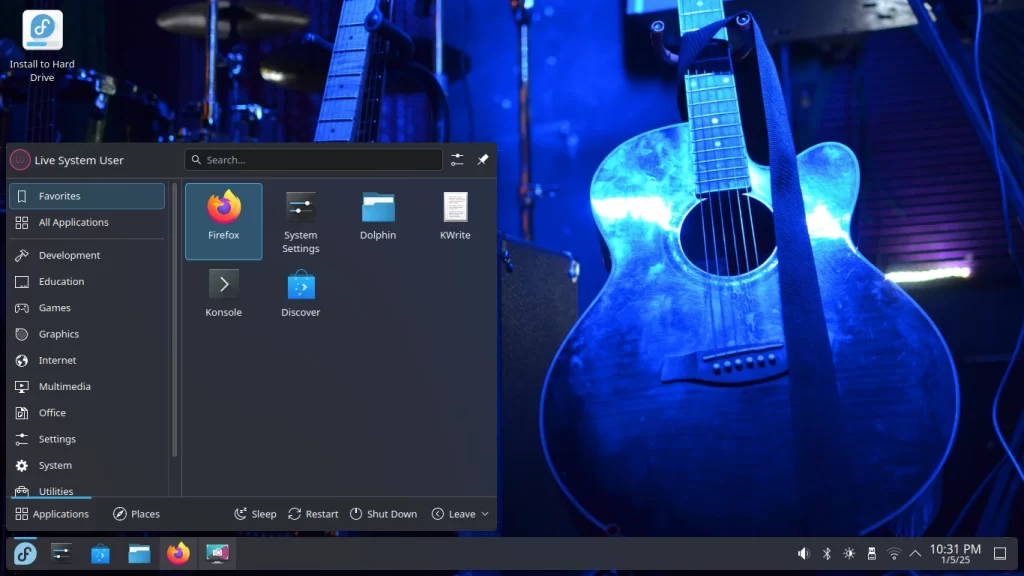
What is Fedora Jam?
Fedora Jam is a specialized spin of the Fedora Linux distribution, curated specifically for audio production, music creation, and sound engineering. It comes preloaded with a suite of tools and applications that cater to the needs of musicians, composers, and audio professionals.
Being part of the Fedora ecosystem, Fedora Jam inherits the stability, cutting-edge technology, and open-source ethos that Fedora is known for. This means users get access to a constantly updated system with a focus on innovation and performance.
Key Features of Fedora Jam
1. Real-Time Kernel for Low Latency
One of the standout features of Fedora Jam is its real-time kernel. This kernel is optimized for low-latency audio processing, ensuring that your recordings and live performances are free from delays and interruptions. For musicians, this translates to a more responsive and reliable experience when working with audio interfaces and MIDI devices.
2. Comprehensive Audio Software Suite
Fedora Jam comes pre-installed with an impressive array of audio tools, including:
- Ardour: A powerful digital audio workstation (DAW) for recording, editing, and mixing audio.
- Hydrogen: A user-friendly drum machine for creating beats.
- Qtractor: A multi-track audio and MIDI sequencer.
- Rakarrack: A collection of audio effects for guitarists and other instrumentalists.
Audacity: A versatile audio editor for recording and editing.
Additionally, Fedora Jam includes JACK (Jack Audio Connection Kit), a professional-grade audio server that allows seamless routing of audio and MIDI data between applications.
3. MIDI and Hardware Compatibility
Fedora Jam excels in supporting a wide range of MIDI controllers, synthesizers, and audio interfaces. Thanks to its real-time kernel and advanced driver support, users can easily connect their hardware and start making music without extensive configuration.
4. Flexible and Modular Setup
Fedora Jam is built with flexibility in mind. Whether you’re a solo artist working on your next album or an audio engineer handling a multi-track recording session, Fedora Jam provides a modular environment that can be tailored to suit your workflow.
Why Choose Fedora Jam in 2025?
1. Open Source Freedom
Fedora Jam adheres to the open-source philosophy, giving users complete control over their system. Unlike proprietary solutions, you’re not locked into expensive licensing models or limited by closed ecosystems. Instead, you’re free to customize and expand your setup as you see fit.
2. Community and Documentation
As part of the Fedora Project, Fedora Jam benefits from a vibrant community of developers and users. The extensive documentation and active forums make it easy to find solutions to any challenges you may encounter. Whether you’re troubleshooting audio issues or looking for tips to optimize your workflow, help is always at hand.
3. Cutting-Edge Technology
Fedora Jam leverages the latest advancements in Fedora’s repositories, ensuring you have access to up-to-date software and features. The inclusion of PipeWire, a modern audio and video server, has revolutionized how Fedora handles audio, offering a seamless and unified experience for both professional and casual users.
4. Eco-Friendly Choice
For those conscious of their environmental impact, Fedora Jam’s ability to run efficiently on older hardware makes it an eco-friendly alternative to resource-hungry proprietary systems. You can create high-quality music productions without needing the latest and greatest hardware.
Getting Started with Fedora Jam
To start your journey with Fedora Jam:
- Download the ISO: Visit the official Fedora Spins website and download the Fedora Jam ISO.
- Create a Bootable USB: Use tools like Rufus or Etcher to create a bootable USB drive.
- Install Fedora Jam: Follow the straightforward installation process to set up your system.
- Explore the Tools: Familiarize yourself with the pre-installed applications and start creating.
In 2025, Fedora Jam remains a powerhouse for music production on Linux. Its combination of low-latency performance, robust software selection, and open-source flexibility makes it an ideal choice for musicians and producers of all levels. Whether you’re a seasoned professional or a hobbyist exploring the world of audio production, Fedora Jam provides the tools and stability you need to bring your musical visions to life.
So, why wait? Dive into the world of Fedora Jam and start creating music with freedom and innovation at your fingertips.
4. KXStudio
In the ever-evolving world of digital audio production, Linux continues to carve a niche for itself, thanks to distributions like KXStudio. As of 2025, KXStudio remains one of the top choices for musicians, audio engineers, and producers who want a stable, open-source platform tailored specifically for music creation. But what makes KXStudio stand out in a sea of Linux distros, and why should you consider it for your studio setup this year? Let’s dive in.
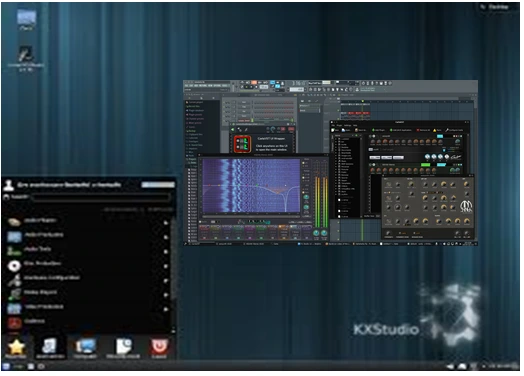
What is KXStudio?
KXStudio is a specialized Linux distribution designed for audio and video production. While it isn’t a standalone operating system anymore, it provides a suite of tools, plugins, and repositories that can be integrated into other popular Linux distributions like Ubuntu or Debian. KXStudio focuses on offering an optimized environment for real-time audio processing, making it a favorite among audio professionals.
Why Choose KXStudio in 2025?
Comprehensive Audio Tools: KXStudio includes a vast collection of tools such as JACK (the Jack Audio Connection Kit), Carla (a powerful audio plugin host), and Cadence (a user-friendly management tool for audio configurations). These tools simplify complex audio workflows.
Real-Time Kernel Support: Audio production demands low latency, and KXStudio supports real-time kernels, ensuring seamless performance during live recordings or mixing sessions.
Wide Plugin Support: With support for LV2, VST, and LADSPA plugins, KXStudio caters to a wide range of audio needs. Whether you’re looking for effects, virtual instruments, or mastering tools, the ecosystem has you covered.
Active Development: Even in 2025, KXStudio benefits from active community support and regular updates. This ensures compatibility with the latest hardware and software advancements in the audio production world.
Open-Source Philosophy: If you’re a fan of free and open-source software, KXStudio aligns perfectly with your values. It offers professional-grade tools without the hefty price tag of proprietary alternatives.
Getting Started with KXStudio in 2025
To use KXStudio, you don’t need to install a separate operating system. Instead, you can add the KXStudio repositories to an existing Linux distribution. Here’s how:
- Choose Your Base Distro: Ubuntu 22.04 LTS or Debian 12 “Bookworm” are excellent choices for stability and compatibility.
- Add KXStudio Repositories: Head to the official KXStudio website and follow the instructions to add their repositories to your system.
- Install Core Tools: Once the repositories are added, you can install tools like Cadence, Carla, and the KXStudio plugins using your package manager.
- Configure Your System: Fine-tune your audio settings with Cadence. Make sure to enable JACK and configure it for low latency.
Key Tools in the KXStudio Ecosystem
- Carla: A versatile audio plugin host that supports VST, LV2, and LADSPA plugins. It also functions as a patchbay for managing audio connections.
- Cadence: The ultimate tool for managing audio drivers, JACK settings, and system configurations. Its user-friendly interface makes it accessible even for Linux newcomers.
- Ardour and LMMS: While not exclusive to KXStudio, these DAWs (Digital Audio Workstations) integrate seamlessly into the ecosystem, offering professional-grade recording and editing capabilities.
- ZynAddSubFX: A powerful open-source synthesizer included in the KXStudio suite, perfect for creating unique sounds.
Advantages of Using KXStudio Over Proprietary Software
- Cost-Effective: Say goodbye to expensive DAW licenses and plugin subscriptions. KXStudio offers everything you need for free.
- Customization: Linux-based systems like KXStudio give you complete control over your setup, allowing for deep customization to suit your workflow.
- Community Support: The active Linux audio community is a treasure trove of knowledge. From forums to detailed documentation, help is always available.
- Lightweight and Efficient: Linux distros are known for their efficiency, and KXStudio is no exception. It’s perfect for running on older hardware without compromising performance.
Challenges to Consider
- Learning Curve: Linux audio production can be daunting for newcomers. However, the tools in KXStudio are designed to ease this transition.
- Hardware Compatibility: While Linux’s hardware support has improved significantly, you may encounter issues with certain proprietary audio interfaces.
- Limited Commercial Plugin Support: Although many open-source plugins are available, some commercial plugins may not work on Linux.
In 2025, KXStudio continues to shine as a robust and reliable solution for music production on Linux. Its rich suite of tools, active community, and commitment to open-source principles make it an excellent choice for anyone looking to explore professional audio production without breaking the bank. Whether you’re a seasoned producer or a hobbyist, KXStudio offers everything you need to turn your musical ideas into reality.
Ready to take the plunge? Install KXStudio today and experience the power of Linux for music production!
5. Linux Mint + Ubuntu Studio Installer
When it comes to music production, Linux has long been overlooked by professionals accustomed to macOS and Windows-based solutions. But in 2025, the landscape is changing rapidly. Linux distributions like Linux Mint and tools like the Ubuntu Studio Installer are making the platform a viable, even exciting, choice for musicians and producers.
If you’re exploring Linux for your music production needs, here’s why Linux Mint combined with the Ubuntu Studio Installer might be the perfect fit.
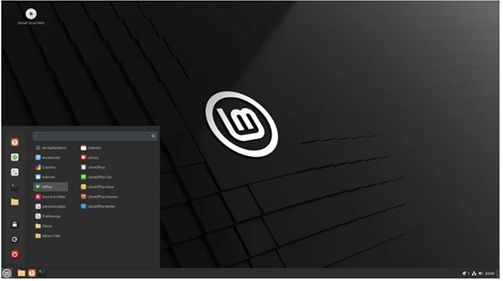
Why Choose Linux for Music Production?
Before diving into specifics, let’s address the big question: Why Linux? The reasons are compelling:
- Cost-Effective: Linux is free to download and use, freeing up your budget for hardware and plugins.
- Performance: Linux systems are lightweight, offering better performance compared to resource-heavy operating systems.
- Customizability: You can tailor your environment to suit your exact workflow.
- Growing Ecosystem: With tools like JACK, Ardour, LMMS, and Carla, Linux has a robust ecosystem for music production.
- Community Support: Linux boasts passionate communities where help is always available.
With these advantages in mind, let’s explore what Linux Mint and the Ubuntu Studio Installer bring to the table.
Linux Mint: A User-Friendly Foundation
Linux Mint has earned its reputation as one of the most beginner-friendly Linux distributions. Based on Ubuntu, it provides a stable and intuitive environment that’s perfect for musicians transitioning from Windows or macOS.
Key Features of Linux Mint for Music Production:
- Cinnamon Desktop: Clean, modern, and easy to navigate.
- Low System Overheads: Ensures more resources are available for audio processing.
- Software Manager: Access to thousands of applications, including music production tools.
- Driver Support: Seamless support for most audio interfaces and MIDI controllers.
Linux Mint’s simplicity ensures you spend less time troubleshooting and more time creating.
Ubuntu Studio Installer: A Game-Changer for Musicians
Ubuntu Studio Installer is a meta-package that transforms any Ubuntu-based distribution, including Linux Mint, into a full-fledged multimedia production powerhouse. It allows you to install all the tools you need for music production with just a few clicks.
What Ubuntu Studio Installer Offers:
Audio Tools:
- Ardour: A professional-grade digital audio workstation (DAW).
- Audacity: For quick audio edits.
- Hydrogen: A versatile drum machine.
- Qtractor: A multi-track sequencer.
Plugins and Effects:
- LADSPA, LV2, and VST plugins for effects and instruments.
- Carla plugin host for integrating various audio plugins seamlessly.
Audio Servers:
- JACK: Low-latency audio routing.
- PulseAudio and PipeWire: For flexible sound management.
MIDI Tools:
- QjackCtl: Simplified JACK control.
- Rosegarden: A MIDI sequencer and notation editor.
Real-Time Kernel:
The installer can enable a low-latency or real-time kernel, ensuring ultra-responsive performance essential for live recording.
With Ubuntu Studio Installer, you can transform Linux Mint into a music production studio rivaling any commercial offering.
Getting Started: Step-by-Step
Here’s how to set up Linux Mint with Ubuntu Studio Installer:
Install Linux Mint:
- Download Linux Mint from linuxmint.com.
- Create a bootable USB drive and install it on your system.
Update Your System:
- Open a terminal and run:
sudo apt update && sudo apt upgrade
Install Ubuntu Studio Installer:
- Run the following commands:
sudo apt install ubuntustudio-installer
Choose Your Workflow:
- Launch the Ubuntu Studio Installer and select the audio tools you need.
Configure JACK:
- Use QjackCtl to set up your audio routing and ensure low-latency performance.
Start Creating:
- Fire up your DAW of choice and start producing!
Tips for Optimizing Linux for Music Production
- Use a Real-Time Kernel: Install and configure a real-time kernel for the best audio performance.
- Disable Unnecessary Services: Free up system resources by disabling background services you don’t need.
- Optimize JACK Settings: Tweak buffer size and sample rate for your specific hardware.
- Backup Your System: Use tools like Timeshift to create snapshots before major changes.
In 2025, Linux Mint combined with the Ubuntu Studio Installer is an unbeatable setup for music production. Whether you’re a seasoned producer or a newcomer, this combination provides a stable, cost-effective, and high-performance platform for all your creative needs.
With the growing ecosystem of tools and the passionate Linux community, there’s never been a better time to embrace Linux for music production. So, why wait? Dive in and start creating your masterpiece today!
Comparison Table
| Feature/Attribute | Ubuntu Studio | AV Linux | Fedora Jam | KXStudio | Linux Mint + Ubuntu Studio Installer |
|---|---|---|---|---|---|
| Low-Latency Kernel | Yes | Yes | Yes | No (can be added) | No (can be added) |
| Preinstalled Tools | Extensive | Comprehensive | Moderate | Not included | Minimal |
| Ease of Use | Beginner-Friendly | Intermediate | Advanced | Advanced | Beginner-Friendly |
| Customizability | Moderate | Moderate | High | Very High | Moderate |
| Best For | Beginners, General | Professionals | Tech-Savvy Users | Audio Professionals | Beginners seeking customization |
Final Thoughts
Linux continues to grow as a viable platform for music production, offering stability, flexibility, and cost-effectiveness. Whether you’re just starting or are an experienced producer, there’s a Linux distro that can fit your workflow.
Ubuntu Studio and AV Linux are fantastic choices for out-of-the-box solutions. Fedora Jam is for those who want cutting-edge tech, while KXStudio offers advanced customization. And if you prefer a more general-purpose setup, Linux Mint with Ubuntu Studio Installer delivers versatility.
Ready to make the switch? Start exploring one of these distros today and take your music production to the next level!
Disclaimer
The information provided in this blog post is for general informational purposes only. While every effort has been made to ensure accuracy, the software landscape is constantly evolving. Users are encouraged to research further and verify that these Linux distributions meet their specific requirements before installation. The author is not responsible for any issues that may arise from following the recommendations provided.
Also Read
Top 5 Linux Distributions for Students in 2025: A Comprehensive Guide

